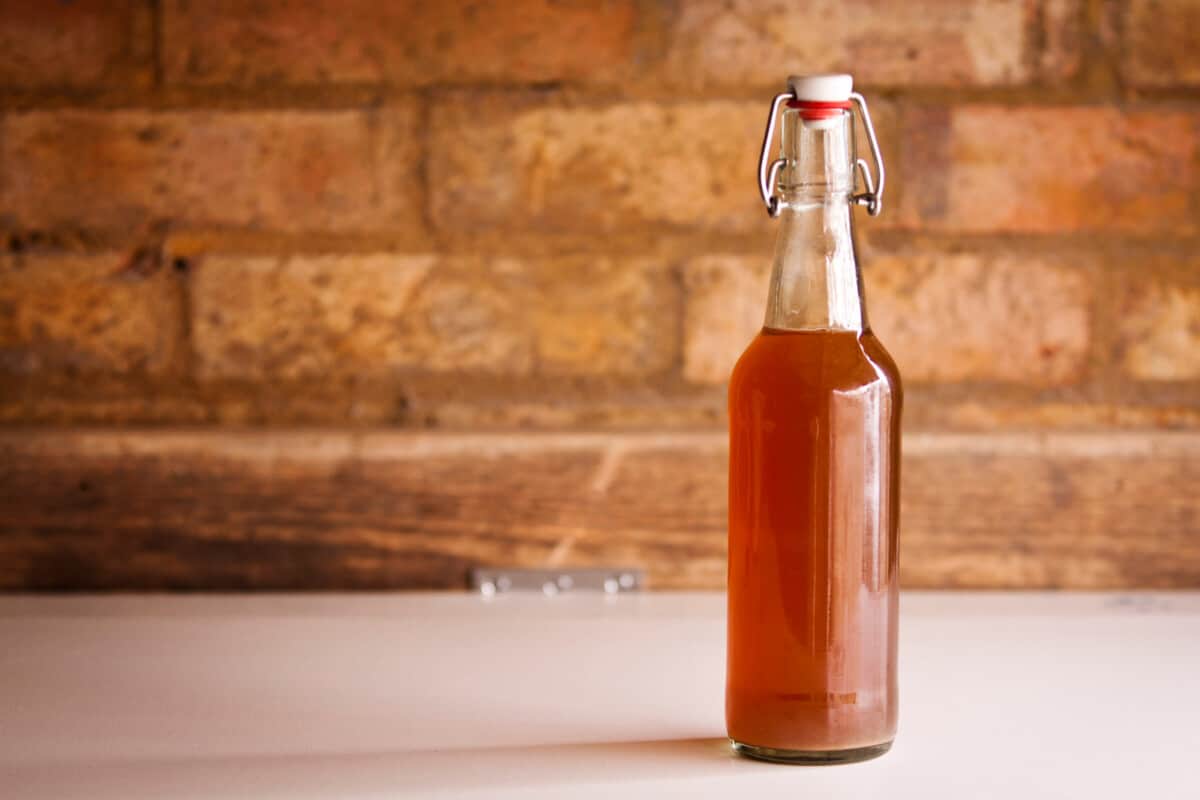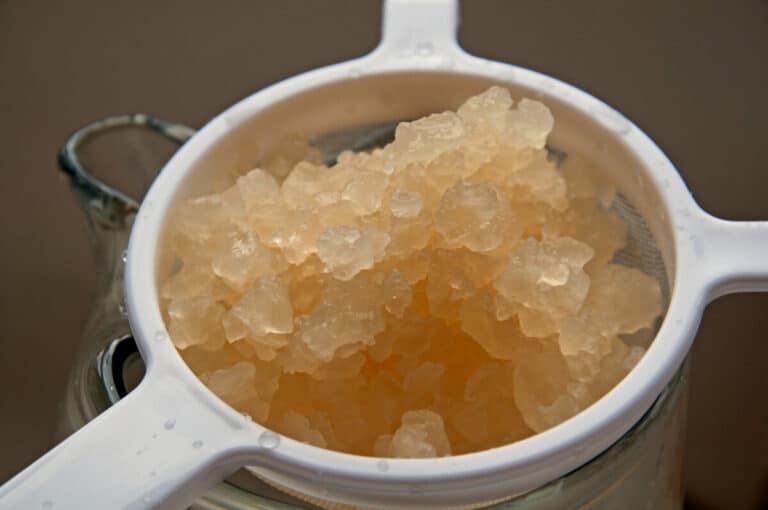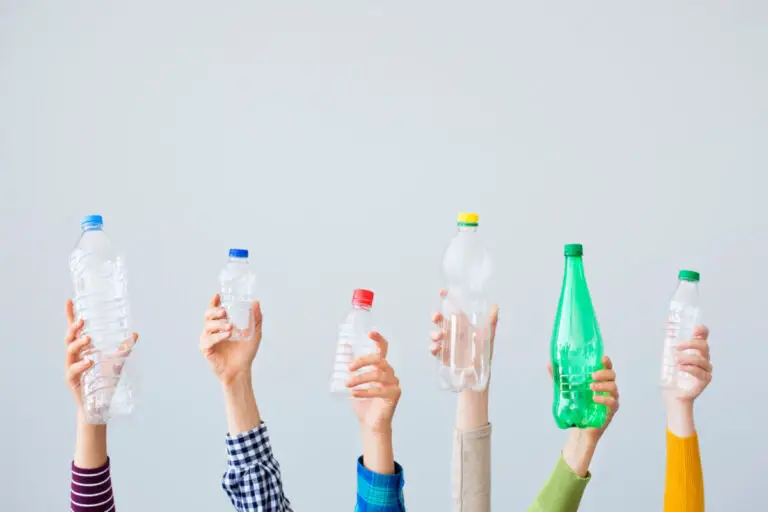Water Kefir Basics: Why Yours Isn’t Fizzy And How to Fix It!
Everyone loves a perfectly fizzy, carbonated kefir drink, but sometimes it is not as easy as it sounds to achieve this. If you are reading this now, you probably ended up with flat water kefir and want to know how to fix it. So why isn’t your kefir carbonated, fizzy, and bubbly?
There are four main reasons why your water kefir is not fizzy:
- The temperature is not warm enough
- Lack of minerals in the mixture the grains are in
- It hasn’t fermented enough (or fermented at all)
- The container/bottle for the second fermentation is leaking air
You have to analyze your water kefir and the environment that it is in to identify the reason (or reasons) why your water kefir is not carbonating how you expect. Below, I will go deeper into each one of those possible problems, how to identify them and how to fix them.
Perfect Temperature For a Fizzy Water Kefir
Too low a temperature is the most common cause for a water kefir drink not being fizzy, sometimes combined with one of the other reasons described in this article.
The ideal range of temperature for a water kefir drink is between 20°-25°C/68°-78°F. If it is below 20°C/78°F your kefir is probably already having a hard time fermenting, so the chances of getting good carbonating are even smaller.
The higher the temperature, the faster the fermentation and the more carbonation.
But if the temperature is too high, it might harm your grains. Many kefirs will resist a temperature higher than 25°C/78°F, but they won’t be in their ideal temperature. My dad lives in a warm city, and his water kefirs are at around 30°C. It is not bad, but if not keeping a close eye, they over ferment really easily.
To check the temperature of your ferment, you will need a thermometer. Many thermometers are suitable, like strip thermometers or food thermometers. I use a digital clock/thermometer to check the temperature of my fermentation station. I leave it inside my cabinet and take a look every now and then. The only thing I have to take into consideration is that the liquids (my kefir and kombucha) will have a temperature a few degrees lower than the ambient temperature (the cupboard).
How to Fix If Your Kefir is in a Low Temperature Environment
So you checked the temperature and realized your water kefir is too cold to ferment properly. Now you have to elevate the temperature stably. I will list a few ways of doing it, but the most important is to keep an eye on it continuously until you get it right and make sure you don’t overheat it and kill your precious water kefir grains.
- Look for a warmer place you can put your kefir. The easiest way is to change where your kefir is. If you have a warmer spot that would be ok to leave your kefir in it, you can check the temperature and move it there. This small change might solve your problem. Quick tip: A place that usually has a suitable temperature is on top of the fridge.
- Use a thermal box. Yes, like those to keep the drinks cold or the food warm. If the temperature is just a few degrees lower, keeping your water kefir inside it might be enough to fix the problem already. However, if the temperature is still too low, consider adding a warm water bottle to it. Remember to test the temperature before putting your water kefir in it.
- Use a seed-growing mat. They are made to keep the temperature of sprouting seeds. If you get one with temperature control, it will keep the ferments at the perfect temperature, but you will need access to a plug. If like me, you have your ferments inside the cupboard, that might be a little challenging.
- Put a hot water bottle inside your cupboard. This was my solution for quite a while. It elevated the temperature but did not keep it stable. I had to be always checking on it and changing the water bottle. Not the best solution, but it does work in the short term.
Are There Enough Minerals on My Water Kefir Mix?
Kefir, more specifically the yeast in the water kefir grains, appreciate minerals and they will thrive in a mineral-rich environment. The source of the lack of minerals can be the water, the sugar, or a combination of both.
The ideal types of water are spring water and mineral water because they have a higher mineral content. Distilled water and reverse osmosis water should be avoided since they have almost no mineral content.
As for sugar, Brown Sugar and Rapadura are the easiest sugars to find with high mineral concentrations. Refined White Sugar is the one with the lowest amount of minerals.
Another solution is to add a little bit of Molasses to your water kefir as a mineral supplementation. Do not use just the molasses, as it can be to strong on the grains if used in place of sugar.
The best way to check if lack of minerals is the reason your kefir is not bubbly is to divide your water kefir grains into two batches of the same size. In the first one, keep using the same ratio and ingredients you have been using and in the second one add a bit of molasses (1/2 tsp is usually enough).
The next day, compare the results and see if it improved your fermentation. If yes, you can change the water/sugar you have been using or just continue to add molasses to your batch.
| Mineral Rich | Mineral Poor | |
|---|---|---|
| WATER | Spring, Mineral, Well | Distilled, reverse osmosis |
| SUGAR | Brown Sugar, Rapadura | Refined White Sugar |
Your Water Kefir is Not Fermenting (Enough)
This one is pretty straight forward. If your water kefir is not fermenting, you won’t have carbonation and you should try to revive your grains or get new grains.
If your water kefir isn’t fermenting ENOUGH then you should find the reason why. It is probably one of the reasons addressed in this article because the base rule is:
More Fermentation = More Carbonation
The Taste Test
To see if your water kefir is fermenting or not, the best is to do a taste test.
- Make your mixture of water and sugar with the normal ingredients and ratio.
- Taste the mixture. If you want you can keep a small amount of the mixture in a container with a lid, so you can taste it again the next day.
- Wait 24 hours
- Taste the water kefir water and compare it to the original mixture.
RESULTS
- If the taste is the same, your water kefir is not fermenting.
- If it is slightly different, but not water kefir taste yet, it is not fermenting enough.
- If it is different, your water kefir it is fermenting, but not carbonating.
You Are Not Using an Airtight Container
You need the air to get trapped, so the carbonation can build up. If you want a soda like water kefir, the best way to get it is to do a second fermentation on an airtight bottle. You can flavor it if you would like or leave it as it is. The fermentation process will continue and since the CO2 produced will be trapped, the drink will become carbonated (fizzy).
One precaution that is needed is to use bottles that can hold pressure and/or remember to “burp” it every day. Burp is a popular term for releasing some of the gas, opening the lid just a bit, and lowering the pressure inside the bottle. If the pressure is more than the bottle can hold, explosions may occur and it is not a fun situation. You can use other kinds of containers, but the same principles apply.

After the water kefir is moved from room temperature to the fridge, the fermentation will slow down and the risk of explosions will drop significantly.
Recap
| PROBLEM | TEST | SOLUTION |
|---|---|---|
| Not Warm Enough | Check the temperature using a thermometer | Elevate the temperature of the environment |
| Low Mineral Content | Divide your water kefir grains in two. Make a base batch and a batch with addition of molasses. Compare both. | Mineral supplementation. It can be swapping ingredients or adding molasses |
| Your Water Kefir is Not Fermenting (Enough) | Do the Taste Test | Find the problem (normally one of the two described before) or get new grains |
| Air is Leaking | Use a airtight container for a second fermentation |




